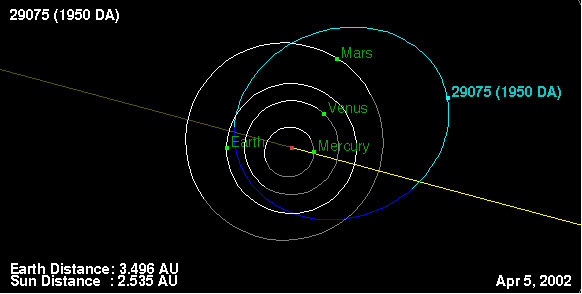Asteroids challenge every law of gravity
A giant asteroid with a special orbital close to Earth is in fact an unusual combination of debris, spinning rapidly at a record speed.
What is surprising here is that such a discrete structure continues to stick together as a unified mass when flying in space, a fact that until now celestial physicists have yet to find a word. solution.
1950 The DA was suddenly famous in 2002, when astronomers claimed that the probability of asteroid 1.3km across the Earth fell to about 1: 300 in 2880. Then this number adjusted down to 1: 19,800. However, just by sweeping the Ground, it can cause a terrible disaster for our planet.

Photo: neo.jpl.nasa.gov
With a 2.2-year orbit around the sun, 1950 the DA is classified as a fast-moving asteroid, and revolves around the axis every 2.1 hours, faster than the limit of centrifugal force used to bind debris. into an asteroid. However, 1950 DA was not torn apart despite the extremely fast rotation speed in space.
Now, researchers at the University of Tennessee (USA) have proposed a new hypothesis to explain the state of the asteroid 1950 DA, whereby they believe that pieces of this object are tied by van de force. Waals , the binding force has never been detected in asteroids.
When analyzing thermal imaging and trajectory models, University of Tennessee expert Ben Rozitis hypothesized that the rotation cycle of 1950 DA was so fast that its equatorial region was negatively gravitational, according to the report. posted on Nature magazine on August 14.
Understanding the structure of asteroids like 1950 DA can help Earth experts find a way to neutralize the threat of the Earth's potential 'assassins' .
- Gravity, gravity and things we still think
- The NASA spacecraft first explored asteroids
- NASA hangs on the asteroid
- Change candidates for hunting asteroids
- 10 interesting things about asteroids in the solar system
- 4 asteroids are threatening the Earth
- Identify asteroids to lead near Earth
- Four asteroids are flying past the Earth
- Asteroids are about to fly through the earth
- Researchers lost 900 marks of asteroids near Earth
- Map of asteroids in the solar system for nearly 20 years
- Thousands of bombs threaten the life of the earth
 Van Allen's belt and evidence that the Apollo 11 mission to the Moon was myth
Van Allen's belt and evidence that the Apollo 11 mission to the Moon was myth The levels of civilization in the universe (Kardashev scale)
The levels of civilization in the universe (Kardashev scale) Today Mars, the sun and the Earth are aligned
Today Mars, the sun and the Earth are aligned The Amazon owner announced a secret plan to build a space base for thousands of people
The Amazon owner announced a secret plan to build a space base for thousands of people NASA begins opening extraterrestrial capsule, risk of strange bacteria entering?
NASA begins opening extraterrestrial capsule, risk of strange bacteria entering?  NASA taps gold mine worth 70,000 times the global economy
NASA taps gold mine worth 70,000 times the global economy  The mystery of the Tunguska explosion may have been solved, the real cause was a drifting meteorite phenomenon
The mystery of the Tunguska explosion may have been solved, the real cause was a drifting meteorite phenomenon  Earth Says Goodbye to 'Mini Moon'
Earth Says Goodbye to 'Mini Moon'  Super telescope finds unbelievable thing flying between Mars and Jupiter
Super telescope finds unbelievable thing flying between Mars and Jupiter  ESA launches Hera spacecraft to study how to protect Earth
ESA launches Hera spacecraft to study how to protect Earth 